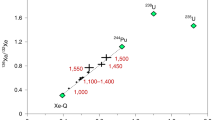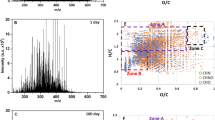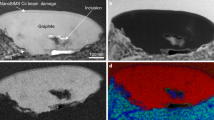Abstract
The signature of carbonate minerals has long been suspected in the mid-infrared spectra of various astrophysical environments such as protostars1. Abiogenic carbonates are considered as indicators of aqueous mineral alteration2 in the presence of CO2-rich liquid water. The recent claimed detection of calcite associated with amorphous silicates in two planetary nebulae3 and protostars4,5 devoid of planetary bodies questions the relevance of this indicator; but in the absence of an alternative mode of formation under circumstellar conditions, this detection remains controversial6,7,8. The main dust component observed in circumstellar envelopes is amorphous silicates9, which are thought to have formed by non-equilibrium condensation10. Here we report experiments demonstrating that carbonates can be formed with amorphous silicates during the non-equilibrium condensation of a silicate gas in a H2O-CO2-rich vapour. We propose that the observed astrophysical carbonates have condensed in H2O(g)-CO2(g)-rich, high-temperature and high-density regions such as evolved stellar winds, or those induced by grain sputtering upon shocks in protostellar outflows.
This is a preview of subscription content, access via your institution
Access options
Subscribe to this journal
Receive 51 print issues and online access
$199.00 per year
only $3.90 per issue
Buy this article
- Purchase on Springer Link
- Instant access to full article PDF
Prices may be subject to local taxes which are calculated during checkout



Similar content being viewed by others
References
Sandford, S. A. Acid dissolution experiments: carbonates and the 6,8-micrometer bands in interplanetary dust particles. Science 231, 1540–1541 (1986)
Lewis, J. S. Low-temperature condensation from the solar nebula. Icarus 16, 241–252 (1972)
Kemper, F. et al. Detection of carbonates in dust shells around evolved stars. Nature 415, 295–297 (2002)
Ceccarelli, C. et al. Discovery of calcite in the solar type protostar NGC 1333-IRAS4. Astron. Astrophys. 395, L29–L33 (2002)
Chiavassa, A., Ceccarelli, C., Tielens, A. G. G. M., Caux, E. & Maret, S. The 90–110 µm dust features in low to intermediate mass protostars: calcite? Astron. Astrophys. 432, 547–557 (2005)
Onaka, T. & Okada, Y. Detection of far-infrared features in star-forming regions. Astrophys. J. 585, 872–877 (2003)
Hofmeister, A. M., Wopenka, B. & Locock, A. J. Spectroscopy and structure of hibonite, grossite, and CaAl2O4: Implications for astronomical environments. Geochim. Cosmochim. Acta 68, 4485–4503 (2004)
Ferrarotti, A. S. & Gail, H.-P. Mineral formation in stellar wind V. Formation of calcium carbonate. Astron. Astrophys. 430, 959–965 (2005)
Tielens, A. G. G. M., Waters, L. B. F. M., Molster, F. J. & Justtanont, K. Circumstellar silicate mineralogy. Astrophys. Space Sci. 255, 415–426 (1998)
Gail, H.-P. & Sedlmayr, E. Mineral formation in stellar winds. I. Condensation sequence of silicate and iron grains in stationary oxygen rich outflows. Astron. Astrophys. 347, 594–616 (1999)
Toppani, A., Libourel, G., Robert, F., Ghanbaja, J. & Zimmermann, L. Synthesis of refractory minerals by high-temperature condensation of a gas of solar composition. Lunar Planet. Sci. Conf. XXXV, abstr. 1726 (2004)
Anders, E. & Grevesse, N. Abundances of the elements: meteoritic and solar. Geochim. Cosmochim. Acta 53, 197–214 (1989)
Abraham, F. F. Homogeneous Nucleation Theory 263 (Academic, New York, 1974)
Chen, L.-C. in Pulsed Laser Deposition of Thin Films (eds Chrisey, D. B. & Hubler, G. K.) 167–198 (John Wiley & Sons, New York, 1994)
McMillan, P. F. & Wolf, G. H. in Structure, Dynamics and Properties of Silicate Melts (eds Stebbins, J. F., McMillan, P. F. & Dingwell, D. B.) 247–315 (Mineralogical Society of America, Washington, USA, 1995)
Ihinger, P. D., Hervig, R. L. & McMillan, P. F. in Volatiles in Magmas (eds Carroll, M. R. & Holloway, J. R.) 67–121 (Mineralogical Society of America, Washington, 1994)
White, W. B. in The Infrared Spectra of Minerals (ed. Farmer, V. C.) 227–284 (Mineralogical Society 4, London, 1974)
Kemper, F., Molster, F. J., Jäger, C. & Waters, L. B. F. M. The mineral composition and spatial distribution of the dust ejecta of NGC 6302. Astron. Astrophys. 394, 679–690 (2002)
Wood, R. F., Leboeuf, J. N., Chen, K. R., Geohegan, D. B. & Puretzki, A. A. Dynamics of plume propagation, splitting, and nanoparticle formation during pulse-laser ablation. Appl. Surf. Sci. 127–129, 151–158 (1998)
Payne, H. E., Philips, J. A. & Terzian, Y. A young planetary nebula with OH molecules: NGC 6302. Astrophys. J. 326, 368–375 (1988)
Marret, S., Ceccarelli, C., Caux, E., Tielens, A. G. G. M. & Castets, A. Water emission in NGC 1333-IRAS4. The physical structure of the envelope. Astron. Astrophys. 395, 573–585 (2002)
Cami, J. et al. CO2 emission in EP Aqr: Probing the extended atmosphere. Astron. Astrophys. 360, 562–574 (2000)
d'Hendecourt, L. B. & Jourdain de Muizon, M. The discovery of interstellar carbon dioxide. Astron. Astrophys. 223, L5–L8 (1989)
de Graauw, T. et al. SWS observations of solid CO2 in molecular clouds. Astron. Astrophys. 315, L345–L348 (1996)
Nisini, B., Codella, C., Giannini, T. & Richer, J. S. Observations of high-J SiO emission along the HH211 outflow. Astron. Astrophys. 395, L25–L28 (2002)
van Dishoeck, E. F. ISO spectroscopy of gas and dust: from molecular clouds to protoplanetary disks. Annu. Rev. Astron. Astrophys. 42, 119–167 (2004)
Gueth, F., Guilloteau, S., Dutrey, A. & Bachiller, R. Structure and kinematics of a protostar: mm-interferometry of L 1157. Astron. Astrophys. 323, 943–952 (1997)
Feigelson, E. D. & Montmerle, T. High-energy processes in young stellar objects. Annu. Rev. Astron. Astrophys. 37, 363–408 (1999)
Molster, F. J. et al. The complete ISO spectrum of NGC 6302. Astron. Astrophys. 372, 165–172 (2001)
Grossman, L. Condensation in the primitive nebula. Geochim. Cosmochim. Acta 36, 597–619 (1972)
Acknowledgements
L. Zimmerman, R. Ruppen and F. Bendisari are thanked for technical help and J. Aléon, E. Deloule and J. Bradley for discussions. C. Kemper is thanked for providing the spectral data of NGC 6302.
Author information
Authors and Affiliations
Corresponding author
Ethics declarations
Competing interests
Reprints and permissions information is available at npg.nature.com/reprintsandpermissions. The authors declare no competing financial interests.
Supplementary information
Supplementary Discussion
This file contains a description of the analytical procedure for the transmission electron microscopy and for the mid and far-infrared spectroscopy. (DOC 28 kb)
Supplementary Figure Legends
This file contains legends for figures 1 to 6. (DOC 36 kb)
Supplementary Figure 1
This figure shows a schematic drawing of the experimental device. (PDF 18 kb)
Supplementary Figure 2
This figure shows the far-infrared spectrum (700–50 cm-1) of Ca-Al-rich material condensed in "wet" CO2 (25°C, 20 mbar H2O + 4 mbar CO2, 493 min). (PDF 173 kb)
Supplementary Figure 3
This figure shows the mid-infrared spectrum (4000–600 cm-1) of material condensed as a function of gas composition. (PDF 229 kb)
Supplementary Figure 4
This figure shows the mid-infrared spectrum (4000–600 cm-1) of material condensed as a function of duration of condensation. (PDF 230 kb)
Supplementary Figure 5
This figure shows the mid-infrared spectrum (4000–600 cm-1) of material condensed as a function of temperature of condensation. (PDF 257 kb)
Supplementary Figure 6
This figure shows the mid-infrared spectrum (4000–600 cm-1) of material condensed as a function of CO2 partial pressure. (PDF 226 kb)
Rights and permissions
About this article
Cite this article
Toppani, A., Robert, F., Libourel, G. et al. A ‘dry’ condensation origin for circumstellar carbonates. Nature 437, 1121–1124 (2005). https://doi.org/10.1038/nature04128
Received:
Accepted:
Issue Date:
DOI: https://doi.org/10.1038/nature04128
This article is cited by
-
Hybrid organic-inorganic materials on the basis of acrylic monomers and TEOS prepared by simultaneous UV-curing and sol-gel process
Journal of Polymer Research (2020)
-
Cometary Refractory Grains: Interstellar and Nebular Sources
Space Science Reviews (2008)
Comments
By submitting a comment you agree to abide by our Terms and Community Guidelines. If you find something abusive or that does not comply with our terms or guidelines please flag it as inappropriate.



